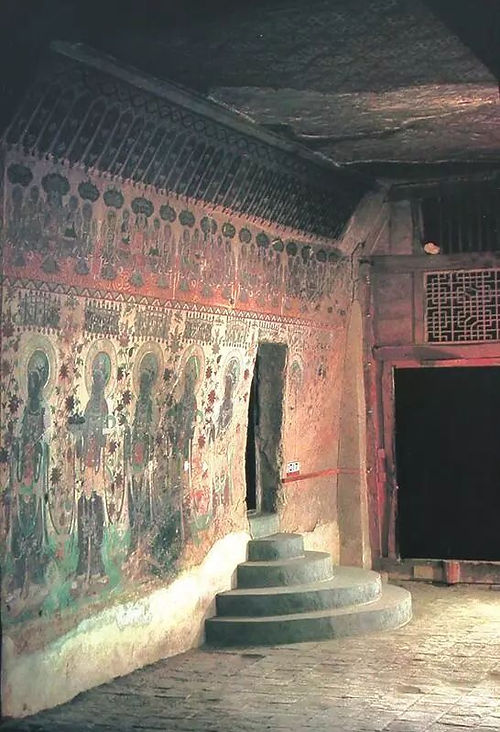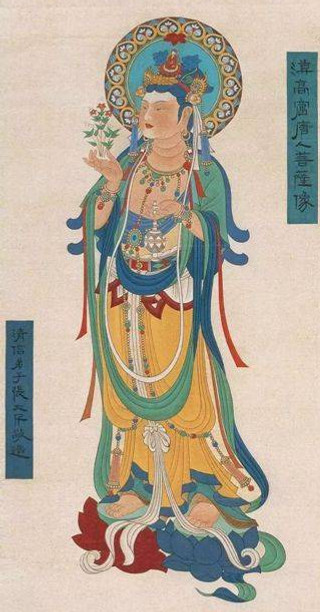Mogao Caves — Exceptional Buddhist Art Wonders on Silk Road
Mogao Caves, or Mogao Grottoes, is an exceptional Buddhist art wonder constructed in 366 in Dunhuang, an important city along the Silk Road.
As a UNESCO World Cultural Heritage site, Mogao Caves preserves numerous murals, sculptures, scrolls, and other relics with unparalleled historical and cultural value.

Mogao Caves in Dunhuang of Gansu Province
Mogao Caves Construction and Meaning
Mogao Caves Facts and Important Data
Cultural Aspects Present in the Art of Mogao Grottoes
Mogao Library Cave and Dunhuang Manuscripts
Events Unfold After Discovering the Sealed Library Cave

Sculptures and Murals (713 — 766) in the 45th Cave of Mogao
Mogao Caves Construction and Meaning
In the year 366, when a Buddhist named Yue Zun was traveling in Dunhuang, suddenly, in the middle of the capacious desert, some golden lights were shed on a cliff, which looked like thousands of Buddhas.
He was impressed by the spectacular scenery and believed that this was the holy place where he wanted to practice Buddhism.
Then he built a Buddhist cave on this cliff.

Mogao Caves in Cliff of Dunhuang, Photo from Official Site of Mogao Grottoes.
Afterward, more caves were constructed there.
Mogao means the high point in the desert or peerless.
It was also named Thousand Buddha Grottoes, which concluded the large numbers of invaluable Buddhist art collections there.

Roof Decoration or Zaojing (618 — 712) of the Mogao Cave 329, Photo by Dongmaiying.
Mogao Caves Facts and Important Data
-
Mogao Caves were first constructed in 366 and lasted for about 1000 years.
-
There are 492 well-preserved caves today.
-
Over 45,000 square meters of murals from different dynasties covered the walls of these caves.
-
More than 2000 painted sculptures, varying from 34.5 meters to 2 centimeters tall, are preserved in Mogao.
-
Over 50,000 scrolls, paintings, and embroidery masterpieces, dating from 405 to 1002, including the world's earliest printed book (Diamond Sutra printed in 868), had been concealed and discovered there.

Mural Meiren Pusa (618 — 712) in the 57th Cave of Mogao Grottoes.
History of Mogao Caves
Located in Dunhuang, an important city along the Silk Road, the destiny of the Mogao Caves matches the prosperity and declination of Dunhuang.
After the first cave was constructed in 366 AD, more grottoes were built there with the support of sincere Buddhist believers, from royals to civilians.
It peaked during the Sui (581 — 618) and Tang (618 — 907) dynasties when trades and communications on the Silk Road were highly prosperous, and Dunhuang was one of the commerce and religious centers.

Murals of the Mid Tang Dynasty (762 — 827) in the 237th Cave of Mogao Grottoes.
It started to decline with the fall of the Tang Dynasty.
Centuries later, it was abandoned under the command of the Jiajing Emperor in 1524, and these artistic wonders were fading in the endless desert.
The city Dunhuang was included and re-established as a town of the Qing Dynasty in 1725 during the Yongzheng Emperor's reign, but the art in the caves of Mogao didn't get the attention it deserved.
In 1900, the sealed Library Cave with tens of thousands of invaluable relics was discovered, leading to significant losses and dispersion worldwide.
In 1987, Mogao Caves was listed as a UNESCO World Cultural Heritage.

Sculptures and Murals in The 427th Cave of Mogao Grottoes (581 — 618).
Cultural Aspects Present in the Art of Mogao Grottoes
As an exceptional wonder on the Silk Road, artworks and documents of Mogao show many cultural aspects of China from the 4th to the 14th century.
Mogao Library Cave and Dunhuang Manuscripts
The Dunhuang Library Cave, also known as Cang Jing Dong, is a small, secret stone chamber located behind the 16th cave of the Mogao Grottoes in Dunhuang.
Sealed around the 11th century, it likely served to avoid the wars of that period, and it has preserved over 50,000 invaluable scrolls, paintings, and embroidery masterpieces.
The Dunhuang Manuscripts concealed in this cave contain documents from 405 to 1002, written in characters of many different ethnic groups.
Besides religious documents, the Dunhuang Manuscripts also include content related to astronomy, calendars, history, philosophy, military affairs, geography, local chronicles, medicine, folk customs, poems, literature, and more.

Details of Part of the Dunhuang Star Map of the Tang Dynasty — British Museum
What Happened After Discovering the Sealed Library Cave and the Extremely Valuable Relics?
In 1900, the sealed Library Cave was discovered by Wang Yuanlu, who had been cleaning, fixing, and rebuilding the declined Mogao Caves.
He reported to officials and governors and even wrote letters to Empress Dowager Cixi.
Still, no one from the ruling class of the Qing Empire showed interest in this discovery.
Wang Yuanlu then disappointedly sealed this cave again.

The Door of the Dunhuang Library Cave or Cangjing Dong, Now Numbered the 17th Cave of Mogao Grottoes.
In 1907, Marc Aurel Stein heard about this cave and arrived in Dunhuang.
Though Wang Yuanlu refused to sell those documents in the Dunhuang Library Cave initially, Stein managed to trick Wang into giving up and purchasing over 9000 pieces of scrolls and other relics with little money; most of them are now preserved in the British Museum.
In 1908, Paul Pelliot picked and bought the most valuable 6000 ancient classics and transported them back to France, which are now in the La Bibliothèque Nationale de France.
In the next few years, Russians, Japanese, and Americans came and took away more scrolls, cut off many frescoes, and painted sculptures.
Besides preserving some remaining scrolls, the Qing government did nothing useful to stop the outflow until the empire ended in 1912.

Statue of the Tang Dynasty from the 328th Cave of Mogao Grottoes — Harvard Art Museums (Photo by Dongmaiying)
Some of those invaluable relics of Mogao that were dispersed worldwide have been well preserved and researched, while others were destroyed.
Wang Yuanlu used all the sold money to fix and rebuild the grottoes and later was widely criticized for being a traitor who caused huge losses to national treasures.
After having realized the enormous value of the scrolls and relics that he sold out, he got depressed, lost his sanity in some gossip, and passed away in 1931.
This valuable art gallery still didn't get sufficient protection during the next few decades of chaotic wars.
From 1940 to 1942, famous artist Zhang Daqian stayed there and copied murals in the caves and did excellent jobs moving those exceptional artistic paintings onto the canvas.
However, some murals of Mogao have more than one layer.
To see these covered frescoes, Zhang Daqian scratched off some valuable murals on the top layers, which caused wide criticism and controversies.

Copied Painting of Mogao Murals by Zhang Daqian
Protection of Mogao Caves Today
After a long period of being buried, robbed, and damaged, Mogao finally found its guardian in Chang Shuhong (1904 — 1994).
He arrived in 1943, established the Dunhuang Academy, and dedicated his life to protecting this place.

Copy Painting of Dunhuang Murals by Chang Shuhong and His Wife Li Chengxian.
Mogao Caves was enlisted as one of the State Priority Protected Sites of China in 1961 and as a UNESCO World Cultural Heritage in 1987.
However, despite all top-level protections, tourists and exposures to humidity, temperature, and lights still are causing irreversible damage to those historic and elaborate artworks.
Therefore, not all caves are open to tourists today, and visitors are not allowed to take photos or stay too long in open caves.
At the same time, more modern technologies are used to display the wonders of the Mogao, including copied caves, digital websites (https://www.e-dunhuang.com/), movies, theaters, videos, etc.

Sculptures and Murals (618 — 712) in the 328 Cave of Mogao Grottoes
You Might Also Like:
Pagodas that Trying to Reach the Sky — Origin, History, and Facts
List of Exceptional Chinese Pagodas
Temple — Religion, Culture, and Art Across Time
Historic Military Defense System and Cultural Icon — The Great Wall of China
Guarding Warriors of the Mausoleum of the First Qin Emperor — Terracotta Army
Ancient Trade Routes That Connected the East and West — Silk Road
Imperial Sacrificial Building Complex of Ming and Qing — Temple of Heaven
The Largest Existing Imperial Palace and Witness of History — Forbidden City
Magnificent Buddhism Palace on Tibetan Plateau — Potala Palace
Imperial Garden with Picturesque Views — Summer Palace
Classical Southern Garden of Borrowed Sceneries — Lingering Garden
Artful Southern Style Classic Garden — Humble Administrator Garden
Royal Mountain Resort In Picturesque Natural Views — Chengde
Localization and Secularization of Buddhist Cave Art — Yungang Grottoes
Royal Stone Carving Museums on Cliff — Longmen Grottoes
Cultural Symbol Across Time and Space — Yellow River or Huang He River
Longest River of China — Yangtze River or Chang Jiang River
Cultural Meanings of Extraordinary Attractions in China
Legend, History, and Culture of Chinese Lakes
History and Culture of Magnificent Mountains in China


